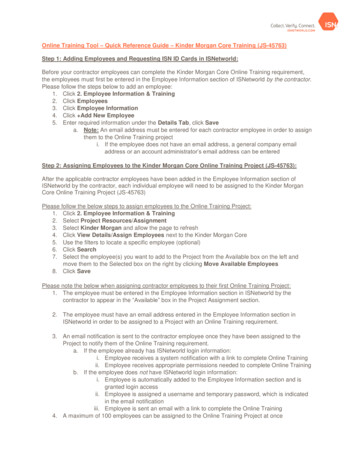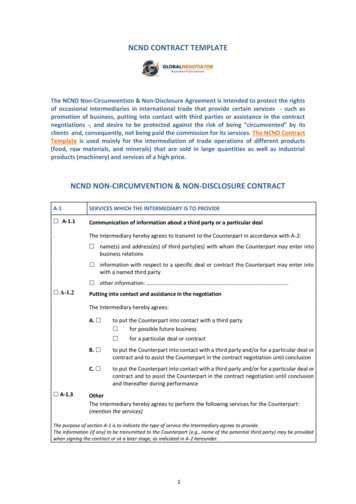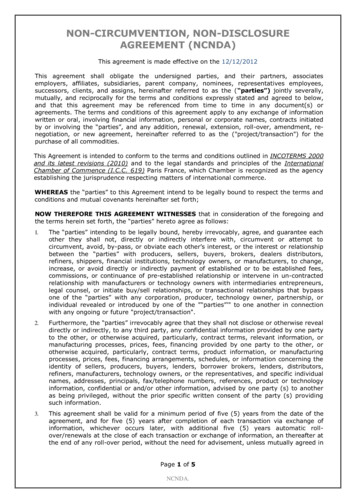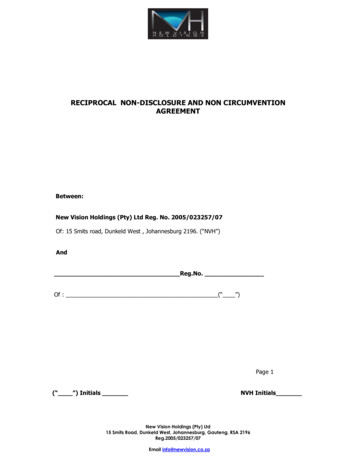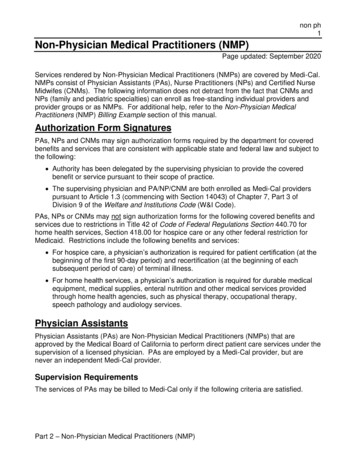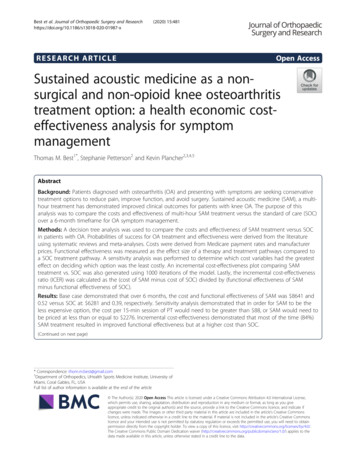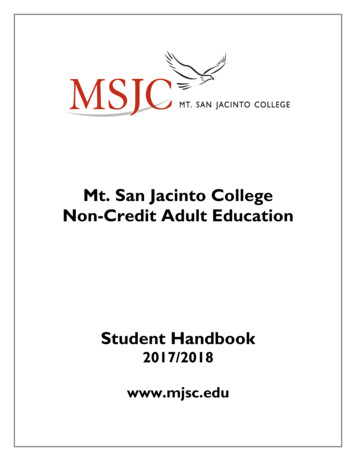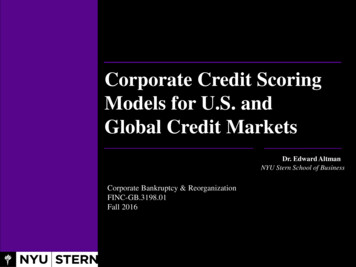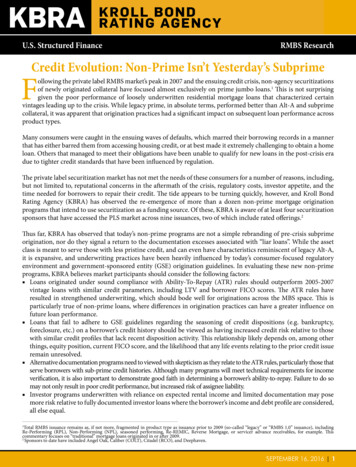
Transcription
U.S. Structured FinanceRMBS ResearchCredit Evolution: Non-Prime Isn’t Yesterday’s SubprimeFollowing the private label RMBS market’s peak in 2007 and the ensuing credit crisis, non-agency securitizationsof newly originated collateral have focused almost exclusively on prime jumbo loans.1 This is not surprisinggiven the poor performance of loosely underwritten residential mortgage loans that characterized certainvintages leading up to the crisis. While legacy prime, in absolute terms, performed better than Alt-A and subprimecollateral, it was apparent that origination practices had a significant impact on subsequent loan performance acrossproduct types.Many consumers were caught in the ensuing waves of defaults, which marred their borrowing records in a mannerthat has either barred them from accessing housing credit, or at best made it extremely challenging to obtain a homeloan. Others that managed to meet their obligations have been unable to qualify for new loans in the post-crisis eradue to tighter credit standards that have been influenced by regulation.The private label securitization market has not met the needs of these consumers for a number of reasons, including,but not limited to, reputational concerns in the aftermath of the crisis, regulatory costs, investor appetite, and thetime needed for borrowers to repair their credit. The tide appears to be turning quickly, however, and Kroll BondRating Agency (KBRA) has observed the re-emergence of more than a dozen non-prime mortgage originationprograms that intend to use securitization as a funding source. Of these, KBRA is aware of at least four securitizationsponsors that have accessed the PLS market across nine issuances, two of which include rated offerings.2Thus far, KBRA has observed that today’s non-prime programs are not a simple rebranding of pre-crisis subprimeorigination, nor do they signal a return to the documentation excesses associated with “liar loans”. While the assetclass is meant to serve those with less pristine credit, and can even have characteristics reminiscent of legacy Alt-A,it is expansive, and underwriting practices have been heavily influenced by today’s consumer-focused regulatoryenvironment and government-sponsored entity (GSE) origination guidelines. In evaluating these new non-primeprograms, KBRA believes market participants should consider the following factors: Loans originated under sound compliance with Ability-To-Repay (ATR) rules should outperform 2005-2007vintage loans with similar credit parameters, including LTV and borrower FICO scores. The ATR rules haveresulted in strengthened underwriting, which should bode well for originations across the MBS space. This isparticularly true of non-prime loans, where differences in origination practices can have a greater influence onfuture loan performance. Loans that fail to adhere to GSE guidelines regarding the seasoning of credit dispositions (e.g. bankruptcy,foreclosure, etc.) on a borrower’s credit history should be viewed as having increased credit risk relative to thosewith similar credit profiles that lack recent disposition activity. This relationship likely depends on, among otherthings, equity position, current FICO score, and the likelihood that any life events relating to the prior credit issueremain unresolved. Alternative documentation programs need to viewed with skepticism as they relate to the ATR rules, particularly those thatserve borrowers with sub-prime credit histories. Although many programs will meet technical requirements for incomeverification, it is also important to demonstrate good faith in determining a borrower’s ability-to-repay. Failure to do somay not only result in poor credit performance, but increased risk of assignee liability. Investor programs underwritten with reliance on expected rental income and limited documentation may posemore risk relative to fully documented investor loans where the borrower’s income and debt profile are considered,all else equal.1Total RMBS issuance remains as, if not more, fragmented in product type as issuance prior to 2009 (so-called “legacy” or “RMBS 1.0” issuance), includingRe-Performing (RPL), Non-Performing (NPL), seasoned performing, Re-REMIC, Reverse Mortgage, or servicer advance receivables, for example. Thiscommentary focuses on “traditional” mortgage loans originated in or after 2009.2Sponsors to date have included Angel Oak, Caliber (COLT), Citadel (RCO), and Deephaven.SEPTEMBER 16, 2016 11
rmbs research september 16, 2016Mortgage Origination OpportunityThe 2010 Dodd Frank legislation and subsequentrulemaking by the Consumer Financial ProtectionBureau (CFPB) introduced standards to ensurethat creditors make a reasonable and good faithdetermination of a borrower’s ability to repay,including the creation of a protected class of “QualifiedMortgages” (QM) in 2014. The QM designationprovides an additional layer of protection against ATRchallenges for lenders and mortgage assignees whenprescribed underwriting practices are followed.While the ATR rule and QM designation haveencouraged many common sense lending practices,implementation costs and heightened liability concernshave substantially restricted the availability of creditto consumers in the non-agency market. Tightenedcredit standards by the GSEs, whose guidelines dictatethe majority of U.S. mortgage production, haveconsumers and lenders seeking alternative productsthat may not meet QM standards or may be solelygeared towards prime borrowers. Certain groups ofconsumers, including self-employed individuals and/or borrowers impacted by the recent credit crisis,may be able to show legitimate ATR compliance butfall short of current credit requirements owing to theflight-to-quality following the Great Recession.Investor DemandFrom the investor perspective, yield has been theprimary impediment to investing in new non-agencyRMBS to date. Interest rates are still remarkably lowand the 10-year Treasury bond yield has continuedto trend lower as the effective Federal Funds rate hasbeen held to near zero since 2009. KBRA recentlycommented in “Low Rates, Low Growth & FallingMarket Liquidity” on the lack of market liquidityand the potential impact to mortgage originators,servicers and overall secondary market activity giventhe lack of profitability in the current environment.But there are areas of the mortgage market emergingthat offer more attractive yields. As non-bank lenderstake an increased share of lending volume, as werecently published in “Mortgage Outlook 2H 2016:As Interest Rates Fall, Non-Bank Share of LendingVolumes Rise” they are also expanding the credit boxto include more non-prime loans and both primeand non-prime loans that do not fit within the QMliability protections.By definition these loan products will inevitablyhave higher rate structures – and can potentiallyhelp yield starved investors boost their returns.However, higher yields typically come with higherrisk, and program guidelines should be reviewedand considered carefully. KBRA has evaluated awide variety of these post-crisis originations frommore than a dozen originators and conduits, andbelow we describe the types of products that haveand are continuing to emerge. Many of theseparticipants believe the addressable market is quitelarge, indicating the market opportunity could be asmuch as 100 billion in UPB or more with certainsegments, such as borrower with prior credit eventsor borrowers needing alternative documentationsources accounting for 20 – 30 billion in UPB each.Prime vs. Non-PrimeWhile 2009-2015 vintage non-agency RMBSwas dominated by jumbo ‘super prime’ collateralcharacterized by historically high weightedaverage (WA) credit scores (i.e. FICOs 750), fulldocumentation, unblemished payment historiesand modest WA loan-to-value (LTVs) (ie. 75),more recent offerings have substantially expanded interms of credit risk. These low yielding, super primeloans have been costly to securitize, and as a resultmany securitization sponsors have or will ceaseissuance by the end of this year, including WinWaterHome Mortgage, Five Oaks Investment Corp. andTwo Harbors Investment Corp.What is left are “non-prime” originations. Theseloans have characteristics that fall outside stringentprime requirements, or are conforming balance loanswhich fail to meet GSE seller guidelines. In reviewingthe growing set of loan products which fit this widedescription, KBRA has identified a set of five subcategories representing common characteristicsacross loan products. Below we present these subcategories along with characteristics that generallydefine them:1. Expanded Prime – Mid-to-lower prime creditscores ( 660 and 750), with minor deviations tocredit, debt-to-income ratio (DTI), or LTV.2. Prior Credit Event – Borrowers with recentforeclosure, bankruptcy, or other loss mitigationdisposition more recent than allowed under GSEguidelines.3. Alternative Documentation – Income documentedthrough sources other than available tax returns,profit & loss (P&L) statements, or Appendix Qrequirements.2
rmbs research september 16, 20164. Business Purpose – Home loans for 1-4 unit rentalproperty outside of allowable GSE guidelines,typically due to a lack of borrower incomedocumentation.5. Foreign National – Borrowers without permanentU.S. residence and a lack of U.S. based credithistory (e.g. no available FICO/US credit report).These loans are being originated in increasingvolumes and carry coupons that are higher thantypical prime market rates.3 Some may still fairlybe characterized as prime from a holistic creditperspective, and along with the remaining nonprime collateral, they are increasingly garneringinvestor interest.Non-Prime vs. Non-QMBefore continuing, it is critical to note that non-primemortgage lending should be distinguished fromloans that fall outside of the QM designation andthose with associated safe harbor protection. Whilemany characteristics that one may associate withnon-prime loans could in fact fall under the non-QMdesignation, the concepts are different. QM eligibleloans require certain qualifying characteristics andunderwriting standards (e.g. terms of 30 years orless, full amortization, DTI less than or equal to 43%using specified calculations, and up-front points/feelimitations).QM standards, notably, do not proscribe anyminimum credit score or maximum LTV. A loancould be non-prime by traditional measures andmeet the definition of QM. Conversely an IO loanto a prime borrower is, by definition, excluded fromQM designation. But the importance of QM statusshould not be ignored given the increased expectedcosts for challenges to non-QM loans that defaultversus QM loans that default.Market constituents should be cognizant of wherenon-prime and non-QM designations overlap.Where this occurs the risk of successful ATR claimsmay greatly increase, a factor we address in our U.S.RMBS Rating Methodology Assessing Non-QM Risk.Investors should also be aware that loans graded withimmaterial or no regulatory compliance exceptionsrelated to ATR may still carry significant risk of notmeeting the rule’s requirements. This is becausethird-party review (TPR) firms which grade for ATRcompliance generally do so based on conformityto seller guidelines and not to what an arbitermay conclude meets ATR. Perfunctory reviews ofguideline compliance with ATR requirements maybe performed by TPR firms, but will likely only findfault if unambiguous exceptions arise (e.g. guidelinesmake no mention of income or asset verificationrequirements). Below, KBRA identifies where someunderwriting characteristics can create higher ATRcompliance risk.Expanded Prime & Non-PrimeOriginationsExpanded PrimeMany of the loans permitted in post-crisis RMBShave been subject to stringent underwriting criteria,with most limiting loan characteristics such as LTV,FICO and DTI to levels associated with prime creditquality. Still, many of these transactions will containsmall portions of loans that did not conform to theserequirements, where the seller waived an exceptionbased on mitigating factors. The expanded primecategory represents borrowers and loans with creditcharacteristics that may have generated a waivedguideline exception, though in small concentrations.Such offerings typically allow for lower minimumFICO scores, generally flooring at 660, while stillrequiring borrowers to have an otherwise primecredit profile. KBRA notes that these programsgenerally utilize limits on risk layering as part of theoverall origination process. More prudent programsmay permit lower-range FICO scores only when theyare accompanied with lower LTVs or full AppendixQ income documentation, which provides specificguidance for determining monthly debt and income.In other cases, expanded guidelines permit higherDTIs that approach or exceed 50%, but in such casessome originators rely on lower LTV and strong credithistory to mitigate increased risk. A borrower’soverall asset profile can also be an important factorwhich can offset income risks. While myriad assettypes may be available for lenders to consider, theliquidity and value volatility of the asset in questionis essential for appropriate accounting.KBRA would generally still consider expandedprime programs to be ‘prime’ where risk-layeringis reduced and a clear ability-to-repay has beendemonstrated and documented. As such, expandedprime loans may span all ATR designations. From3Weighted average coupons (WAC) on the recent COLT 2016-1 and 2016-2 collateral were 6.96% and 6.98% respectively, while WACs forpost-crisis prime jumbo offerings have generally been well below 5%, and typically closer to 4%.3
rmbs research september 16, 2016a holistic perspective, KBRA believes the risk thatsuch loans will not meet ATR is relatively low andgenerally comparable to prime loans which havebeen securitized post-crisis.Prior Credit EventLoans to borrowers with prior adverse credit eventshave garnered significant non-agency demand in theaftermath of the financial crisis. Target borrowersmay have been subject to foreclosure or bankruptcyproceedings, or have been permitted to enter into ashort sale or deed-in-lieu of foreclosure. Borrowersthat otherwise may qualify for an agency loan maybe restricted from GSE financing due to seasoningrequirements for credit events (see general GSEseasoning requirements in the table below). Theseasoning periods that appear in the table representthe waiting times generally required by the GSEs fromthe completion of a foreclosure, deed-in-lieu, shortsale, charge-off date, or other relevant discharge/dismissal date. Loans with these characteristics bearthe most similarity to pre-crisis subprime loans.Source: Fannie Mae Selling Guide and Freddie Mac Single Family Seller/Servicer Guide, August 2016.* Shortened requirements are limited for certain non-owner occupiedassets and/or cash out refinancings.Programs allowing for loans with prior credit eventsmay allow for FICO scores as low as 500, while someprograms may still limit borrowers to a minimumof 600 or 620. Required LTVs are typically below80% and similar to GSE guidelines, many programsrequire that the prior credit event be resolved andseasoned for a minimum period of time before thenew application. Still, many programs do differ inregard to these seasoning requirements. For example,some may permit recent credit events with less than24 months seasoning from resolution, while othersrequire no seasoning at all.Holding other factors constant, KBRA believesborrowers with recent credit events present moredefault risk than those which have met the seasoningrequirements in the GSE guidelines. The degreeto which default likelihood increases may differdepending on seasoning, payment history, LTV,current FICO, as well as documented levels ofincome and employment. KBRA believes that marketconstituents should grant favorable consideration tolenders of this loan product where the underwritershave taken prudent steps to document and considerthe circumstances leading to the credit issue. Thesemay include a significant life event outside of theborrower’s control, such as unexpected and significantmedical bills, as opposed to financial mismanagement,which should be viewed less favorably. Unfortunately,many programs which allow for credit events do notperform this level of review.When evaluating loans to borrowers with subprimecredit, an evaluation of underwriting practices andlayered risk are important factors in KBRA’s ratingsanalysis. A key consideration is documentingincome in a manner that is compliant with AppendixQ, which is present in some current non-primelending programs. As with expanded prime loans,logical LTV limits are also important elements thatare evaluated when programs are reviewed, which isin turn considered in the rating process.Given the importance of LTV, we believe appraisalpractices and declining market adjustmentsmerit special attention for programs that allowhigher LTV limits. In general, KBRA has notedmany strong attributes of post-crisis originationpractices in regard to some of these non-primeprograms including full IRS transcript reviews,fraud monitoring, enhanced appraisal reviews andbroker/correspondent monitoring. From a creditperspective, KBRA believes that those lenders whoadhere to such standards will find that borrowerswith similar credit attributes to those of pre-crisisoriginations should outperform legacy subprimedue to substantially improved origination practices.There is no requirement for a lender to consider aborrower’s prior credit history for QM assigneeliability protections to apply. However, in the casewhere a loan does not meet QM standards (andoften ‘prior credit event’ loans may not, by virtue ofthe points and fees charged by the borrower), ATRdoes require that the lender consider the borrower’scredit history in making a reasonable and good faithdetermination of the borrower’s ability to repay under4
rmbs research september 16, 2016the ATR rules. While the rule does not prescribeany credit score consideration or cut-off, we expectthat non-QM loans to consumers with very recentcredit event resolutions will have a high burden toovercome if a borrower raises a foreclosure defenseunder the ATR rules. KBRA believes compellingevidence of changed circumstances since the eventcan play a key role in mitigating both the credit andcompliance risk of loans to borrowers with priorcredit issues.Alternative DocumentationRMBS issuance of agency and non-agency mortgagesfrom 2010 through 2015 have been predominantlycharacterized as having full documentationof income, assets, and employment. However,some borrower demand exists for lower formsof documentation, typically from self-employedborrowers who cannot qualify for traditional loansbased on tax return analysis and high net worthborrowers who do not show regular income butcan demonstrate significant reserves and assets.While ATR rules prohibit ‘stated doc’ and ‘no doc’consumer-purpose loans, to meet borrower demand,KBRA has observed two main types of alternativeincome documentation processes: bank statementverification and asset depletion.KBRA believes that programs which only rely on bankstatements for verification of income are at higherrisk of default, all else equal, than programs whichreview tax returns and/or P&L statements. The risksfor such loans may vary depending on the time perioddocumented, the underwriting applied, whetherbusiness and personal statements are reviewed,whether the source of deposits is documented, andthe borrower’s employment status and history. Mostbank statement income documentation programswhich KBRA has reviewed are geared specificallytoward self-employed borrowers and many require24 consecutive months of activity.Market constituents should be aware that significantvariation exists among bank statement programs. Thosewhich review a longer history (e.g. 24 months) will bepositioned to more accurately judge the borr
issuance by the end of this year, including WinWater Home Mortgage, Five Oaks Investment Corp. and Two Harbors Investment Corp. What is left are “non-prime” originations. These

